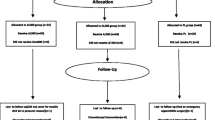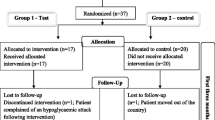Abstract
A study was undertaken for evaluating the hypoglycemic and hypolipidemic effects of an ayurvedic medicine “Rajanyamalakadi” containing Curcuma longa, Emblica officinalis and Salacia oblonga in type II diabetic patients over a period of 3 months. Ethical committee consent for the study was given by the Director, Indian Systems of Medicine, Kerala. A total of 43 patients with established diabetes mellitus as adjudged from clinical features and FBS values, appeared for the camp (Age group 35–75 yrs). An informed consent for the study was obtained from each patient. The clinical proforma was given to each patient to collect data such as height, weight, diet pattern, previous history of illness etc. The ongoing antidiabetic medications were stopped under medical supervision and the patients were provided with ‘Rajanyamalakadi’ tablets (dose 1–2 tablets each weighing 500mg). The dosage of the drug was decided by the supervising medical officer on a case to case basis, taking note of the clinical conditions and responsiveness of the patients. The patients were monitored for three months, who were divided into 6 groups based on their age and again into two groups, 5 & 6, based on their mean FBS values. ie; Normal Persons, Diabetics of age groups 35–45yrs, 46–55yrs, >55yrs and those with FBS < 145.9 mg% and > 145.9 mg%. The Ayurvedic medicine “Rajanyamalakadi” has showed significant antidiabetic, hypolipidemic and antioxidant effects. In addition to that significant ameliorating effects on the elevated serum AST and ALT activities were also demonstrated by the treatment. The nutraceuticals present in the drug like Terpenoids, Polyphenols, Curcumin etc are responsible for the medicinal effects.
Similar content being viewed by others
References
Mokdad AH, Ford ES, Bowman BA, Diabetes Trends in the US 1990–1998 Diabetes Care 2000; 23:1278–1283.
Paulose KP, Regi Jose, Augusti KT, Joseph PK. in Diabetes mellitus and its management edited by Dr.Paul Augustine, Regional cancer centre, Thiruvananthapuram and published by Health Forum of the School of medical education, M.G.University, Kottayam — 2001; PP 6–46: 65–84.
Diabetes Mellitus: Report of a WHO study group. World Health Organ. Tech Rep Ser 1985L; 727: 1–113.
Inzucchi SE. Oral antihyperglycemic therapy for type 2 diabetes. Scientific review. JAMA 2002; 287(3): 360–372.
Nadkarni, Dr. K.M.1976. The Indian Materia Medica, with Ayurvedic, Unani and Home Remedies. Revised and enlarged by A.K.Nadkarni. 1954.
Kirtikar KR, Basu BD. Indian medicinal plants Vol I. 1984. 2nd edn. PP 582, 1541. Bishen singh Mahendra pal singh, Dehradun.
Augusti KT, Joseph P, Babu TD. Biologically active principles isolated from Salacia oblonga wall. Ind Physiol Pharmacol 1995; 39(4): 415–417.
Krishnakumar K, Augusti KT, Vijayammal PL. Antiperoxidative and hypoglycemic activity of Salacia oblonga extract in diabetic rats. Pharmaceutical Biology 2000; 38(2): 101–105.
Muruganandan S, Srinivasan K, Gupta S, Gupta PK, Lal J. Effect of Mangiferin on Hyperglycemia and atherogenicity in streptozotocin diabetic rats. J Ethnopharmacol 2005; 97(3): 497–501.
Mentreddy, Rao S. Medicinal Plant species with potential antidiabetic properties. J Sci Food Agriculture 2007; 87(5): 743–750.
Yoshikawa M, Murakami T, Shimada H, Matsuda H, Yamahara J, Tanabe G, Muraoka O. Salacinol, Potent antidiabetic principle with unique thiosugar sulfonium sulphate structure from the ayurvedic traditional medicine Salacia reticulate in Srilanka and India. Tetrahedron Letters 1997; 38(48): 8367–8370.
Srimal RC. Curcumin in drugs of the future. Phytotherapy 1997; 68: 483–493.
Polasa K, Sesikaran B, Krishnaswamy K. Antimutagenicity of curcumin and turmeric. Proc Nutr Soc Ind 1990; 36: 102.
Bhattachrya A, Chatterjee A, Ghosal A, Bhattacharya SK. Antioxidant activity of active tannoid principles of Emblica officinalis (amla). Ind J Exp Biol 1999; 37(7): 676–680.
Scartezzini P, Speroni E. Review on some plants of Indian traditional medicine with antioxidant activity. J Ethnopharmacol 2000; 71(1–2): 23–43.
Jose JK, Kuttan R. Antioxidant activity of Emblica officinalis J Clin Biochem Nutr 1995;19: 63–70
Thakur CP. Emblica officinalis reduces serum, aortic and hepatic cholesterol in rabbits. Experentia 1985; 41: 423–424.
Dhir HI, Agarwal K, Sharma A, Talukdar G. Modifying role of Phyllanthus emblica and ascorbic acid against nickel elastogenecity in mice. Cancer Letters 1991; 59(1): 9–18.
Babu PS, Srinivasan K. Hypolipidemic action of curcumin, the active principle of turmeric (Curcuma longa) in stretozotocin induced diabetic rats. Mol Cell Biochem 1997; 166(1–2): 169–175.
Krishnakumar K, Augusti KT, Vijayammal PL. Hypoglycemic and antioxidant activity of Salacia oblonga wall extract in streptozotocin — diabetic rats. Ind J Physiol Pharmacol 1999; 43(4): 510–514.
Cherian S, Kumar V, Augusti KT. Antidiabetic effect of a glycoside of pelargonidin isolated from the bark of Ficus bengalensis Linn. Ind J Biochem Biophys 1992; 29: 380–382.
Krishnakumar K. Biochemical investigations on the active principles isolated from Salacia oblonga wall, Ph.D. thesis submitted to the University of Kerala. 2000: 71–86.
K Sreenivasan. Plant foods in the management of diabetes mellitus: Spices as beneficial antidiabetic food adjuncts. Int J food Sciences and Nutrition 2005; 56(6): 399–414.
Tank R, Sharma N, Sharma I, Dixit VP. Antidiabetic acitivity of C.Ionga in alloxan induced diabetic rats. Indian drugs 1989; 27(11): 587–589.
Rai MK. A review of some antidiabetic plants of India, Ancint Science Life 1995, 14(93): 168–178.
Free AH. Advances in Clinical Chemistry, edited Sobotka H, Stewart CP, Academic press, NewYork 1963; 6: 67.
Yallow RS. Immunoassay of endogenous plasma insulin in man. J Clin Invest 1960; 39: 1157–1175.
Trivelli LA, Ranney HM, Lai HT. Haemoglobin components in patients with Diabetes Mellitus. N Eng J Med 1971; 284: 353–357.
Allain CC, Poon LS, Chan CSG, Richmond W, Fu PC. Enzymatic determination of total Serum Cholesterol. Clin Chem 1974; 20: 470–475
Fossati P, Prencipe L. Serum triglycerides determined colorimetrically with an enzyme that produces hydrogen peroxide. Clin Chem 1982; 28(10): 2077–2080.
Friedewald WT, Levy RI, Fredrickson DS. Estimation of the concentration of low density lipoprotein cholesterol in plasma, without use of the preparative ultracentrifuge. Clin Chem 1972; 18(6): 499–502.
Falholt, K, Falhott, W, Lund B. An easy colorimetric method for routine determination of free fatty acids in plasma. Clin Chem Acta 1973; 46: 105–111.
Anila L, Vijayalakshmi NR. Flavonoids from Emblica officinalis and Mangifera indica-effectiveness for dyslipidemia. J Ethnopharmacol 2007; 79(1): 81–87.
Srivastava SK, Beutler E. Transport of oxidized Glutathione from human erythrocytes. J Biol Chem 1969; 244: 9–16.
Reitman S, Frankel S. Colorimetric determination of SGOT and SGPT activity. Am J Clin Path 1957; 28: 56–63.
Natelson S, Thomas CC. Springfield, Illinois. Microtechniques of Clinical Chemistry for the routine laboratory. 1957; P. 381.
Brod J, Sirota JH. The renal clearance of endogenous creatinine clearance in man. J Clin Invest 1948; 27: 645–651.
Pallant, J. SPSS Service Manual. A service guide to data analysis using SPSS for windows (version 10) Allen and Anwin 2001.
Raynald Levesque, SPSS Programming and Data management. A guide for SPSS and SAS users, Fourth edition (2007), SPSS Inc., Chicago Ill.
Augusti, KT, Sunil NP, Abraham A, Thomas S, Chemmanam V. A comparative study on the effects of diet and exercise, metformin and metformin + pioglitazone treatment on NIDDM patients. Ind J Clin Biochem 2007; 22(2): 65–69.
Author information
Authors and Affiliations
Corresponding author
Rights and permissions
About this article
Cite this article
Faizal, P., Suresh, S., Satheesh Kumar, R. et al. A study on the hypoglycemic and hypolipidemic effects of an ayurvedic drug Rajanyamalakadi in diabetic patients. Indian J Clin Biochem 24, 82–87 (2009). https://doi.org/10.1007/s12291-009-0014-1
Published:
Issue Date:
DOI: https://doi.org/10.1007/s12291-009-0014-1




